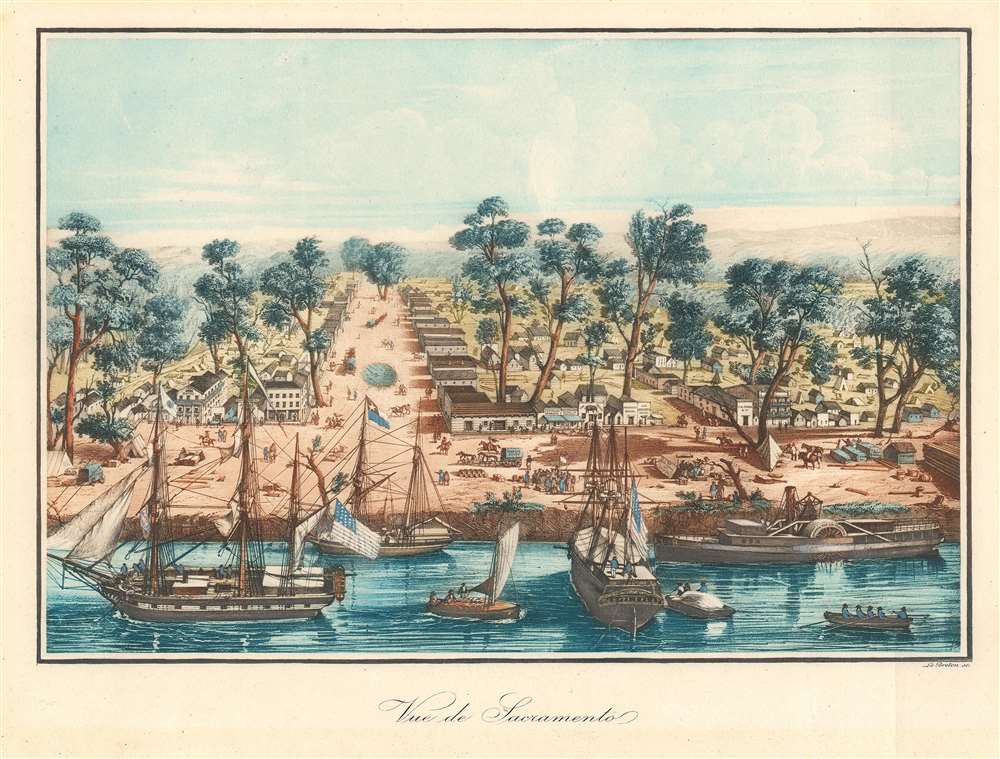This item has been sold, but you can get on the Waitlist to be notified if another example becomes available, or purchase a digital scan.
1849 / c. 1910 Le Breton View of Sacramento, California
VuedeSacramento-lebreton-1854
Title
1854 (undated) 9.5 x 14.5 in (24.13 x 36.83 cm)
Description
A Closer Look
This view presents the waterfront or Embarcadero of Sacramento, now known as the 'Old Sacramento Waterfront,' looking east down what became J Street. The names of shops and businesses are visible and the image of a bustling settlement on both land and water is emphasized. Several ships sit along the waterfront, including a steamboat bound for San Francisco and a Chilean trading ship.The still-ad hoc nature of the city is reinforced by the pitched tents scattered around the background, presumably belonging to prospectors. In the 1850s, the railroad would arrive with a station right at the Embarcadero and railyards to the north (left) of the area depicted here, leaving a deep impact on the city.
After decades of neglect, restoration efforts of the historic center of Sacramento began in the 1960s and it was registered as a State Historic Park and on the National Register of Historic Places. It has become popular with tourists in the years since and hosts several museums and historical sites, including the California State Railroad Museum.
Sacramento's Early History
Although a part of Spanish and then Mexican California, the area that is now Sacramento was only very loosely controlled or administered prior to California's admission the United States following the Mexican-American War. The city's roots trace back to the scheme of John Augustus Sutter, a Swiss-born traveler and adventurer who gained from the Mexican governor of California the right to establish a fort and settlement at the confluence of the Sacramento and American Rivers, which he dubbed New Helvetia (New Switzerland). The settlement was welcoming of Americans and other outsiders, and Sutter readily employed native peoples in his own private army and in other functions.But the January 1848 discovery of gold in the American River by one of his employees at what became known as Sutter's Mill in Coloma fundamentally changed Sutter and Sacramento's fortunes. Prospectors and other migrants began arriving in large numbers, causing all manner of disruptions, including mistreatment of Native Americans and slaughtering of Sutter's cattle. Sutter's son advocated building a rationally planned city on a grid structure based around the Embarcadero to accommodate the growing population. The elder Sutter was very unhappy with this scheme, the renaming of the town to Sacramento, and the other sudden changes, and retired to a quiet rural life where he reaped a relatively small gain from the discovery of gold on his land. His son's approach and business acumen were vindicated in time, as Sacramento overcame floods, fires, and other issues in its early years to become a thriving city, being designated as the state's capital in 1854.
Publication History and Census
This view was prepared by the French painter Louis Le Breton, depicting the city in the early 1850s. The dating of this view is highly uncertain, with examples being dated anywhere from teh 1850s to the 1920s. Le Breton is also credited with a larger format print of the same view that is held by the University of California Berkeley and dated to 1851. Otherwise, this view is not known to be held by any institution and is scarce to the market.Cartographer
Louis Le Breton (January 15, 1818 - August 30, 1866) was a French medical doctor and maritime painter active in the middle part of the 19th century. He was born in Douarnenez,, France to a long line of doctors. He studied medicine at the L'École de Médecine de la Marine de Brest (1837 - 1837), subsequently joining the navy as surgeon. Le Breton is notable for having taken part in the third Jules Dumont d'Urville (1790 - 1842) voyage (1837 - 1841). He initially joined the expedition on board the Astrolabe as a surgical assistant. Breton was distantly related to d'Urville and leveraged his family connections for a place on the prestigious circumnavigation. In the early days of the expedition, Le Breton befriended the expedition's official painter, Ernest Goupil (1814 - 1840), under whom he studied marine painting, quickly exhibiting a natural proficiency. In 1840, when Goupil died of dysentery in Hobart, Tasmania, Le Breton took over the artist's official duties. When the voyage returned to Paris, he was knighted as a Chevalier de la Légion d'Honneur and on D'Urville's recommendation worked in subsequent years compiling the Atlas du Voyage for D'Urville's official account. He returned to the sea in 1844 on board the Cradle, again as a surgeon, returning to Paris in 1846. From 1847, he dedicated himself fully to painting, formally resigning his naval commission in 1848. Afterwards, he worked as a draftsman and engraver, famously producing graphic illustrations of demons for Collin de Plancy's Dictionnaire Infernal. Le Breton died in Paris of cholera in 1866. More by this mapmaker...

